The fifth block of Castlevania III‘s “true” route is one of the most unusual stages in the game. It does several very interesting (and sometimes very surprising) things as it sends you deep beneath the lake through a series of crumbling catacombs that ultimately lead to the castle’s lowest foundations. It’s possibly the longest stage in the game, depending on how you play it, and it eventually splits into two separate paths. Even the music is uncharacteristic, lacking the usual bold melodies and driving beats of the Dracula’s Curse soundtrack in favor of an eerie, almost atonal tune.

Unusual feature number one: Almost every enemy to appear in this block comes from Castlevania II. You don’t see them on the alternate route at all, but here they are in full force. It neatly reinforces the idea that the sprawling journey to the castle in this game covers some of the same ground as Simon’s Quest — that it’s all part of the big, happy Transylvanian world view.
Floating eyeballs, walking homunculi of flame, leaping slime-balls, mummies….
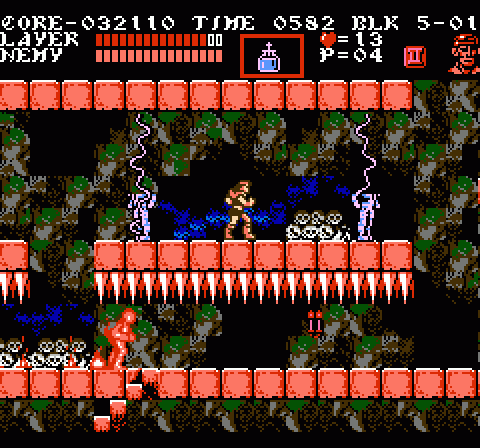
…all of these guys showed up in Simon’s Quest. But they were stupid and pointless in Simon’s Quest, to be honest. They did very little of interest, mostly shambling around on wide expanses of landscape. Here, that’s not the case at all. Each of these creatures demonstrates its own distinct behaviors, and each one occupies space within the level design that makes them dangerous and forces you to pay attention. Basically, Block 5 redeems Simon’s Quest‘s bestiary.
The slimes, for example, leap in a low arc that’s usually too low to hit even if you duck — until they get close and make a huge, sudden, jumping attack right at you. The mummies don’t simply march back and forth; now they function like weaker versions of the mummy bosses, “materializing” into the level by forming from a stream of wrappings, then flinging their bandage fragments as you. They like to surround you and appear in greater numbers, with reinforcements arriving infinitely for every one you strike down. The eyeballs drift around as before, but now they drop fireballs that burn momentarily on the ground. The longer you let them fly, the more treacherous they make the environment. Likewise the fire golems, which leave a trail of flame behind them that obstructs your forward progress. They usually patrol areas featuring the stage’s low, spike-lined ceilings, so you can’t simply jump over the fire.
In fact, the prevalence of spikes here removes a key component of the Castlevania arsenal by preventing you from jumping. It’s even worse for Grant, whose big advantage in cramped quarters like these is normally his ability to cling to ceilings and circumvent danger. Obviously, that tactic doesn’t work so well here.
Block 5 mirrors the larger stage progression by offering upper and lower routes through the level, each presenting their own hazards. The upper tier tends to feature tougher foes, while the bottom tier tends to feature more dangerous and restrictive environmental hazards.
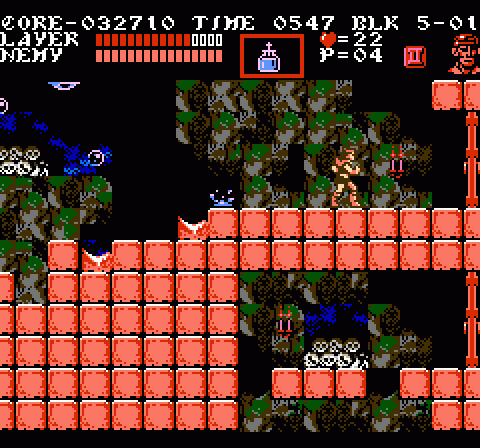
Another cool portion of this level: Acid droplets that drip from above. Nothing new there; Mega Man 2‘s final stage consisted entirely of those things, and as usual being struck by one causes Trevor or Grant damage. What makes these droplets stand out is the fact that they burn through the stage blocks. One drop can dissolve one stone block, eating away at secure footing and changing the nature of the ground you stand on. Certain areas actually allow you to wait out the acid to expose a route to obstructed paths — though it’s also possible to wait too long and end up unable to advance because the acid has burned away all the platforms. This is something you probably don’t want to do.
Block 5 really commits to its parallel-path design, with several of its substages ending with two different doors. Both doors take you to the subsequent stage, but you have your choice of how to proceed. Neither upper nor lower route is radically, overwhelmingly different from the other, but the divergence allows you to experience the stage in different ways.
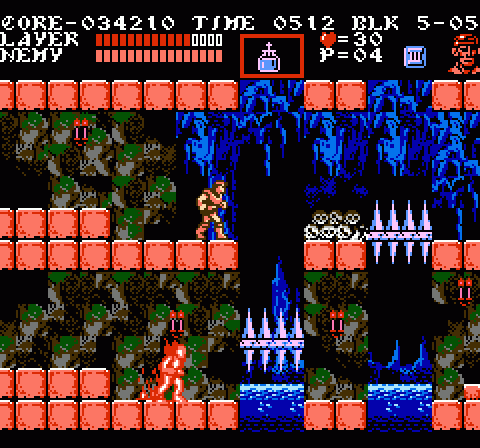
The going grows gradually more difficult the further you delve into the stage. Several of the substages are incredibly short — only a couple of screens long — so Block 5 has an unusual flow, broken into quick pieces of similar design.
Once the moving spike traps come into play, the upper route becomes the easier one to navigate (since jumping over spikes below is easier than jumping beneath spikes above, you know, since you jump in an upward arc). Later you encounter plunging spike pressing that drop and rise again on a chain, like those in Stage 06 of Castlevania. This might cause a moment of panic for experienced players, because in Castlevania those traps were deadly to the touch, no matter how you approached them. Here, though, you actually have to walk along their upper surface to advance.
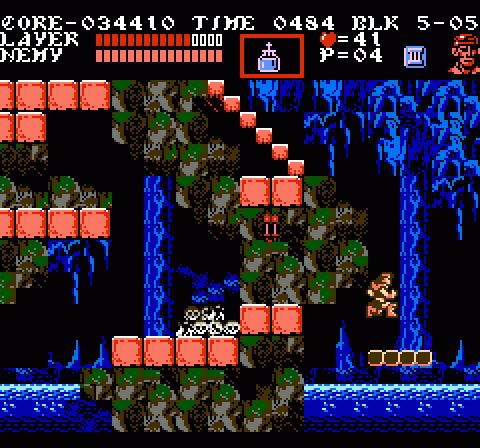
Finally, you take a floating platform to a high staircase leading upward, perhaps to take you out of the catacombs at last…?
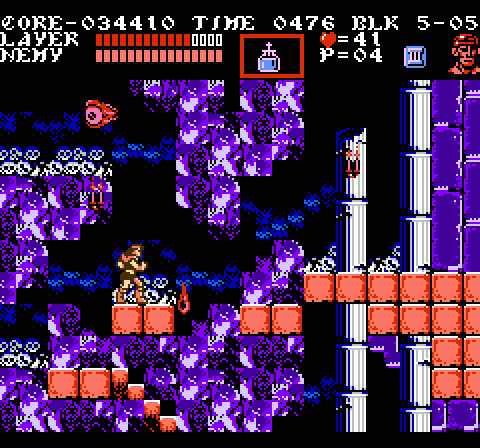
Or perhaps simply to a more purple area of the catacombs. The organic caverns start to give way here to more defined, man-made architecture — deliberate brickwork, crumbling columns, and a shrine where the boss lives… in a coffin, beneath a cross.
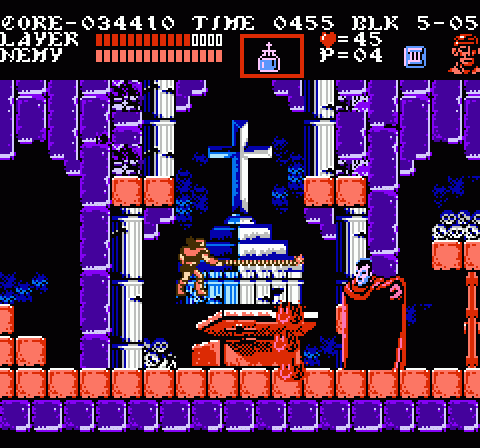
So, yeah, this is a total pants-wetting “holy crap” kind of moment your first time through the game: Here, in the middle of nowhere, is Dracula! He appears in a cloud of bats which coalesces into a tall vampire cloaked in red, who flings a trio of fireballs at you before dissolving into bats again and fluttering across the room. If you’ve completed the original Castlevania, you know exactly how to deal with this guy: Jump and hit his head, which is his one vulnerable point, and strike the fireballs out of the air. Repeat until victory, and which point he transforms into a demon and the real fight begins…

…or not. Actually, what happens is that he shrinks down to human height and joins Trevor’s quest as an alternate character, unless you wanna keep Grant. Turns out this is Dracula’s son Alucard (originality apparently wasn’t one of the Tepes family’s strong suits) who will tag along and lend his very limited array of skills to the cause of defeating his father. A teenage rebel in formal evening wear.
Beyond Alucard’s lair, Block 5 continues for at least one more sub-stage where you can take Alucard’s new abilities for a spin. What you will find is that Alucard is very tricky to use, and like Trevor his basic attack has to be powered up twice to reach maximum potential (which means every time you die you’ll have to collect four of those little power-up symbols in order to allow your team to rise above “suck” status). He offers a very useful and very specific special skill, but he lacks the hardcore destructive potential of Sypha or the carefree maneuverability of Grant. An “expert mode,” if you will.
Clearly, he learned a lot between now and 1797.
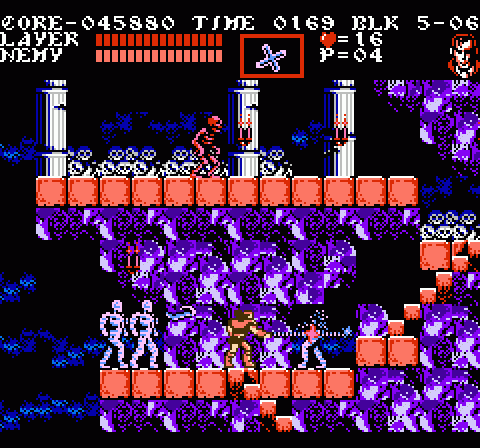
The path beyond Alucard turns out to be much harder than the road leading up to him. The game really loves to hit you with those materializing mummies as soon as you enter a new area, surrounding you with them as soon as you climb up onto a platform. Making your way through here without taking a severe beating is much more easily said then done — though, fortunately, if you don’t survive the gauntlet you’re only sent back to the beginning of Block 5-06 rather than being catapulted all the way back to 5-01.
Block 5-06 actually isn’t so long when you lay its screen geography out end-to-end, but it sure seems like a real gauntlet thanks to the nasty enemies you face — and it’s topped off with yet another path selection screen.
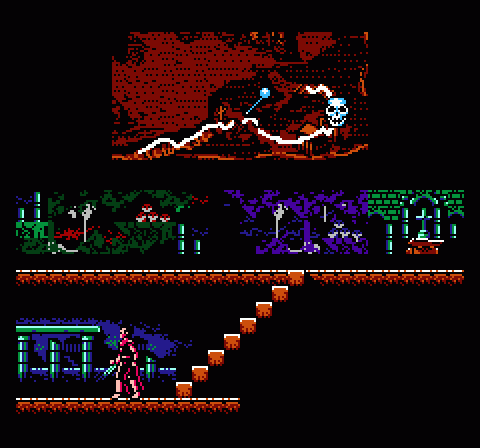
Hmm, wherever does this take us?
I’m sad this is almost coming to an end. I didn’t even notice that this stage had all those enemies from CV2. Maybe because I played the games out of order back then and it was all just one big experience, but it’s nice to know that detail.
Those pincer mummies are bastards. Grant’s options are a little more limited in this stage, but I found his climbing handy for getting back to the upper path when I realized the lower path was all spikeville and I was at a disadvantage staying down there.
Alucard’s boss sprites look really goofy, especially his face. His fight’s very much like a bargain bin Dracula, fitting when you consider his origins. You would think Drac’s son would be a great ally, but compared to the wall climber and magic user he’s not really that useful.
There are some places only Al can get to, but he’s definitely the least useful of the three. Guy really got his shit together for his own game, though.
I hope to hear how Alucard can potentially be great, rather than being the booby prize for buying into the whole “Dracula’s Son” bit and the character-swapping gimmick.
…he can potentially be great, right?
@LBD “Nytetrayn”: I dunno all the specifics of Al (I think he has crappy fireballs that become slightly less crappy fireballs?), but his ability to transform into a bat can be pretty handy sometimes. Or at least it would be moreso if you didn’t already have a guy who can climb on surfaces like Spider-Man, without consuming hearts to do so.
…Crap, I wanna check this out now. Guess it’s time for name entering exploits again! I love that I can do that with Castlevania III. ^_^
Grant was fairly useful here for the acid bits, but that’s about it.
Okay, I just ran through Block 1 and the first couple of sections of Block 3 with each of the three partners. Here’s my impressions.
Grant: Knife is as strong as Trevor’s default whip. He has short attack range, but stabs really quickly. Can’t upgrade his weapon. Can climb on walls and ceilings, though cornering is tricky. Shares the knife, axe, and watch sub-weapons with Trevor and can use them while hanging on walls. Has control over his jump range and direction. Is a smaller target. Takes one more bar of damage than Trevor.
Sypha: Staff is as strong as Trevor’s default whip. Her staff also has better range than Grant’s knife and she can swing it just as fast. Can’t upgrade her weapon. Has awesome spells that can burn, freeze, and home in on enemies and only cost a single heart to use. Same size as Trevor. Takes one more bar of damage than Trevor.
Alucard: Fireball is weaker then Trevor’s default whip, weak enough that it take two hits for him to kill Medusa Heads and owls. His fireball has the best range of default attacks, but is as slow to use as Trevor’s whip strikes. He can upgrade his weapon, but it increases in quantity, not quality. Attack is best used at closer range so more fireballs hit the thing you want dead, which of course puts him at risk. He can’t use his fireballs on stairs, so he’s defenseless there. Has no sub-weapons. Can transform into a little bat and fly around all over the place, but it consumes about two hearts a second and he can’t defend himself. Is a slightly larger target than Trevor in human form. Takes the same damage as Trevor.
All in all, I’d consider Grant and Sypha both better options than Alucard. They do take more damage than Al, but Grant’s got great mobility while still having better options to defend himself and Sypha’s magic outclasses Al’s single crappy attack in every way with way less risk involved.
Pretty much all Al’s got going for him is turning into a little bat, which he needs because his attacks are shit. You’re better off just using those upgrades on Trevor’s whip, leave Al for flying the fuck away from things.
Thanks, Jeremy, another great entry. CV3 was actually my first NES game - my family was late to the party. I loved it back then, of course. But now I’m really appreciating it as an 8-bit masterpiece.
I usually spend my time here lurking but I had to de-cloak and tell you how much I enjoy these “Anatomy of” pieces. They’re absolutely fantastic. Any chance of seeing these in print? I’d be willing to part with many paper dollars.
A Castlevania NES trilogy book will be available in a few weeks with a Zelda/Zelda II book to follow soon after.